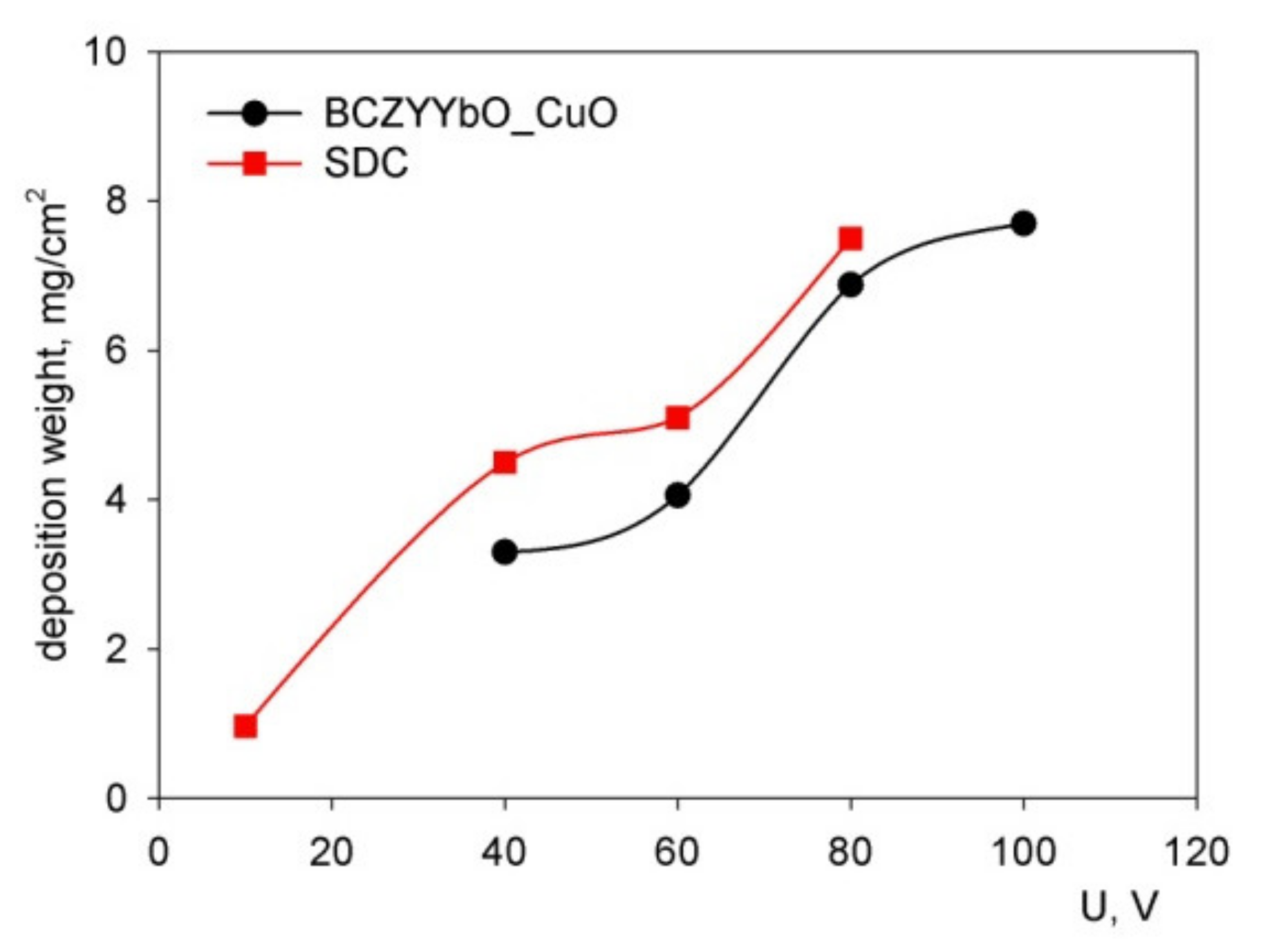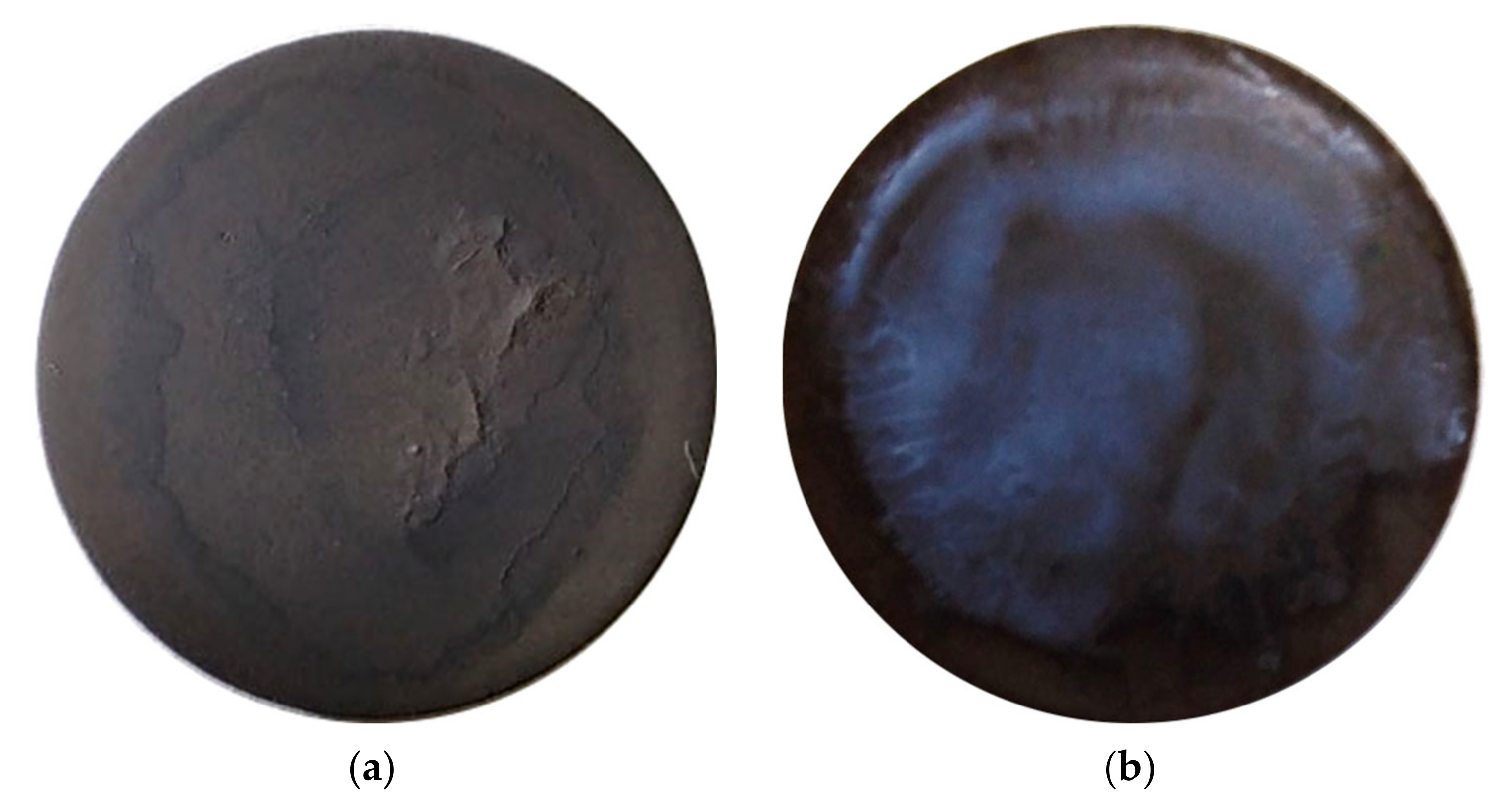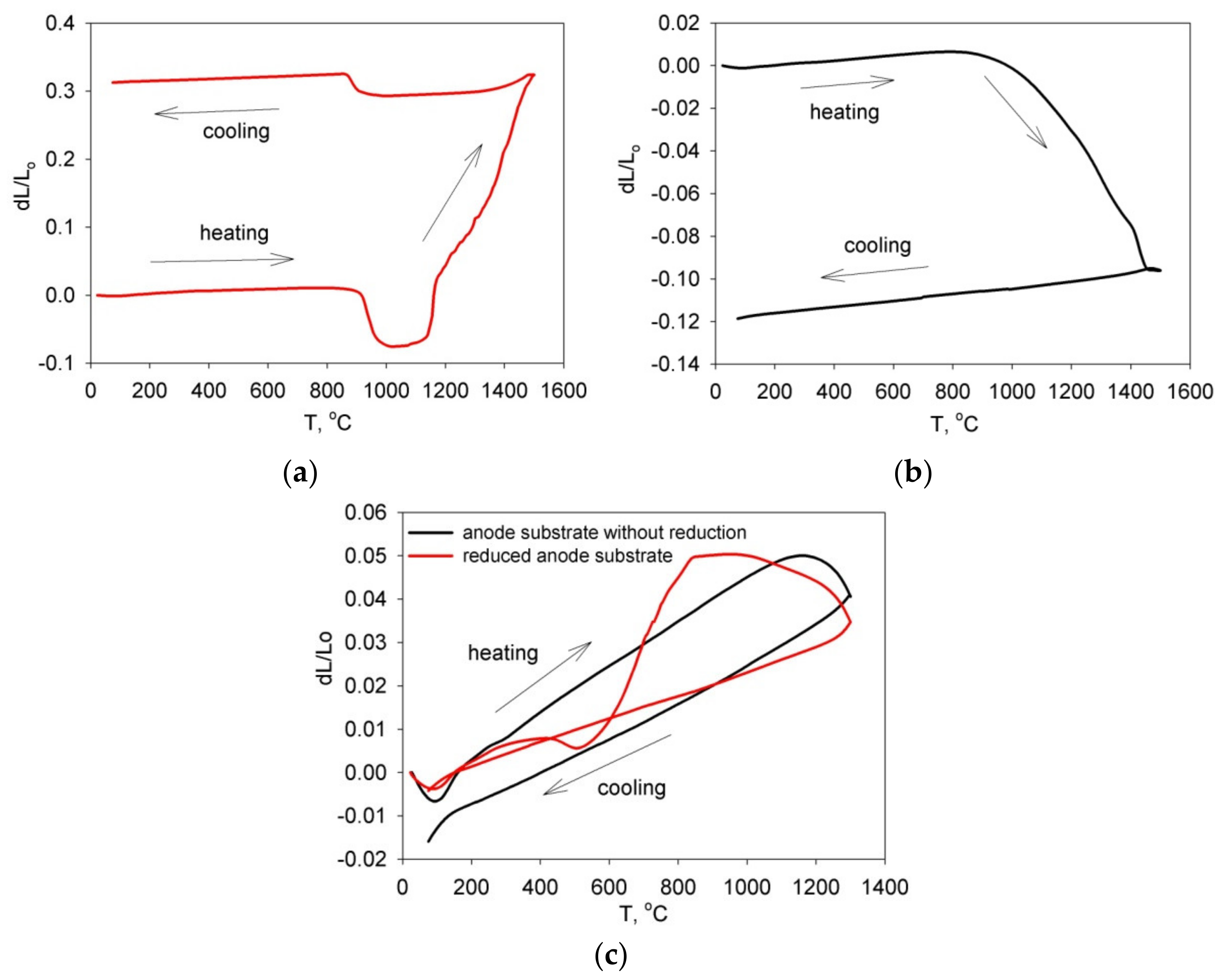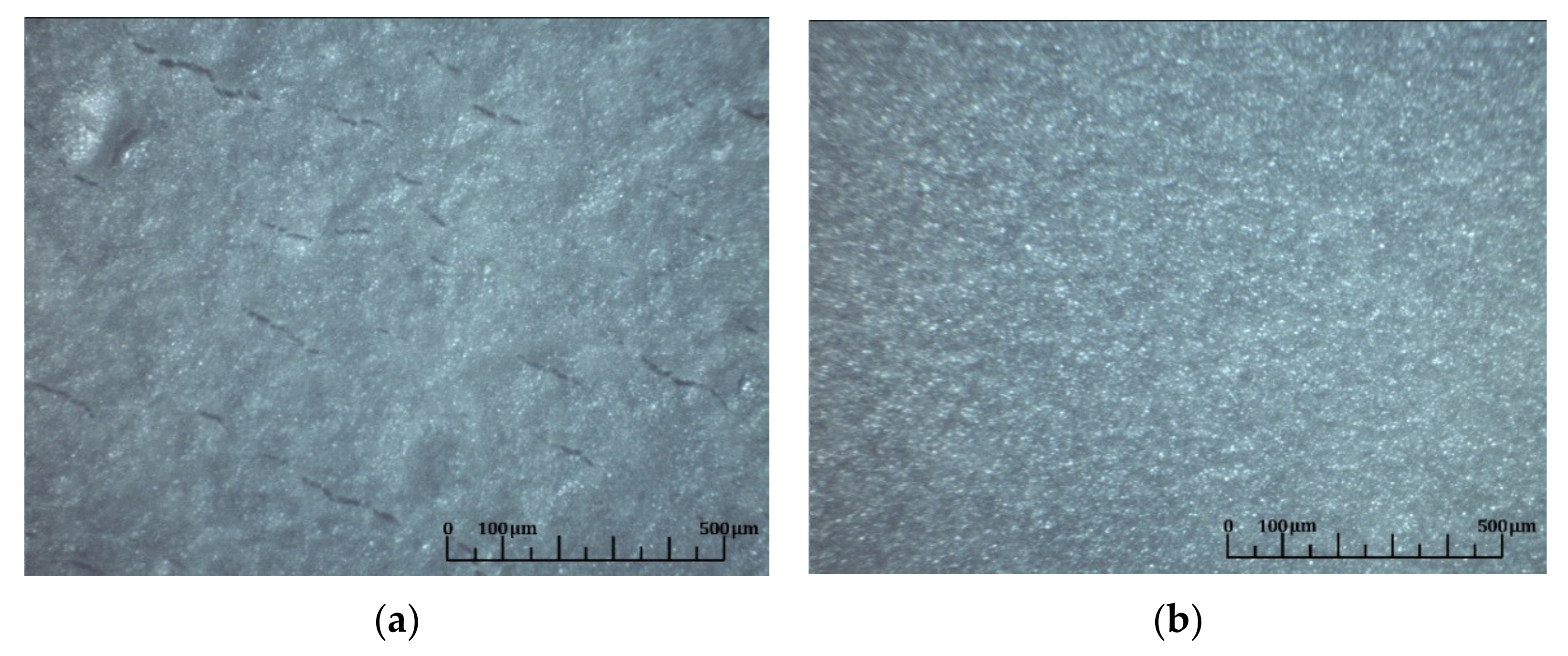Challenges of Formation of Thin-Film Solid Electrolyte Layers on Non-Conductive Substrates by Electrophoretic Deposition
Abstract
1. Introduction
2. Materials and Methods
2.1. Synthesis and Characterization of the Electrolytes
2.2. Fabrication of the Anode Substrates and Their Characterization
2.3. Preparation of the Suspensions Based on the Electrolyte Materials and Their Characterization
2.4. Electrophoretic Deposition of the Thin-Film Electrolyte Layers
3. Results and Discussion
3.1. Characteristics of Electrolyte Powder Materials
3.2. Fractional Composition and Electrokinetic Potential of the Suspensions of the Powder Electrolyte Materials
3.3. Investigation of EPD of Electrolyte Materials on a Model Substrate (Ni-Foil)
3.4. Formation of an Electrolyte Layer on Porous Anode Substrates by the EPD Method
3.4.1. Direct EPD on Non-Conductive Porous Substrates
3.4.2. EPD on Reduced NiO-SDC Substrates
EPD of a Two-Layer BCZYYbO-CuO/SDC Electrolyte on a Reduced NiO-SDC Anode Substrate
EPD of a Single-Layer SDC Electrolyte on a Reduced NiO-SDC Anode Substrate
3.4.3. EPD on Porous Anodes with a Conductive Pt Sublayer
3.4.4. EPD of the Single Layer SDC Electrolyte Film on the NiO-SDC Porous Substrates Pre-Sintered at Decreased Temperatures
| Anode Substrate | Conducting Layer | SDC Film Thickness, μm | SDC Film Sintering Mode | Characteristics of the SDC Film Surface |
|---|---|---|---|---|
| NiO-SDC + 20% graphite powder | Ppy | 8 | 1450 °C, 5 h | Unsintered film with numerous edge cracks (Figure 13a) |
| NiO-SDC | Ppy | 7 | 1450 °C, 5 h | Unsintered film with few cracks |
| NiO-SDC | Ppy | 7 | 1500 °C, 5 h | Unsintered film, no cracks (Figure 13b) |
| NiO-SDC | Pt | 8 | 1450 °C, 5 h | Unsintered film, no cracks |
3.5. Microstructure of EPD Coatings Deposited on Model Ni Foil and Dense SDC Substrates
4. Conclusions
Supplementary Materials
Author Contributions
Funding
Institutional Review Board Statement
Informed Consent Statement
Data Availability Statement
Acknowledgments
Conflicts of Interest
References
- Su, H.; Hu, Y.H. Progress in low-temperature solid oxide fuel cells with hydrocarbon fuels. Chem. Eng. J. 2020, 402, 126235. [Google Scholar] [CrossRef]
- Sreedhar, I.; Agarwal, B.; Goyal, P.; Singh, S.A. Recent advances in material and performance aspects of solid oxide fuel cells. J. Electroanal. Chem. 2019, 848, 113315. [Google Scholar] [CrossRef]
- Tucker, M.C. Progress in metal-supported solid oxide fuel cells: A review. J. Power Sources 2010, 195, 4570–4582. [Google Scholar] [CrossRef]
- Nguyen, X.V.; Chang, C.T.; Jung, G.B.; Chan, S.H.; Yeh, C.C.; Yu, J.W.; Lee, C.Y. Improvement on the design and fabrication of planar SOFCs with anode–supported cells based on modified button cells. Renew. Energy 2018, 129, 806–813. [Google Scholar] [CrossRef]
- Ishihara, T.; Shimose, K.; Kudo, T.; Nishiguchi, H.; Akbay, T.; Takita, Y. Preparation of yttria-stabilized zirconia thin films on strontium-doped LaMnO3 cathode substrates via electrophoretic deposition for solid oxide fuel cells. J. Am. Ceram. Soc. 2000, 83, 1921–1927. [Google Scholar] [CrossRef]
- Solov’ev, A.A.; Shipilova, A.V.; Ionov, I.; Kovalchuk, A.N.; Rabotkin, S.V.; Oskirko, V.O. Magnetron-sputtered YSZ and CGO electrolytes for SOFC. J. Electron. Mater. 2016, 45, 3921–3928. [Google Scholar] [CrossRef]
- Park, B.K.; Barnett, S.A. Boosting solid oxide fuel cell performance via electrolyte thickness reduction and cathode infiltration. J. Mater. Chem. A 2020, 8, 11626–11631. [Google Scholar] [CrossRef]
- Prakash, B.S.; Pavitra, R.; Kumar, S.S.; Aruna, S.T. Electrolyte bi-layering strategy to improve the performance of an intermediate temperature solid oxide fuel cell: A review. J. Power Sources 2018, 381, 136–155. [Google Scholar] [CrossRef]
- Hou, J.; Bi, L.; Qian, J.; Zhu, Z.; Zhang, J.; Liu, W. High performance ceria–bismuth bilayer electrolyte low temperature solid oxide fuel cells (LT-SOFCs) fabricated by combining co-pressing with drop-coating. J. Mater. Chem. A 2015, 3, 10219–10224. [Google Scholar] [CrossRef]
- Hu, S.; Li, W.; Yao, M.; Li, T.; Liu, X. Electrophoretic deposition of gadolinium-doped ceria as a barrier layer on yttrium-stabilized zirconia electrolyte for solid oxide fuel cells. Fuel Cells 2017, 17, 869–874. [Google Scholar] [CrossRef]
- Hui, R.; Wang, Z.; Kesler, O.; Rose, L.; Jankovic, J.; Yick, S.; Maric, R.; Ghosh, D. Thermal plasma spraying for SOFCs: Applications, potential advantages, and challenges. J. Power Sources 2007, 170, 308–323. [Google Scholar] [CrossRef]
- Wen, J.; Song, C.; Liu, T.; Deng, Z.; Niu, S.; Zhang, Y.; Liu, L.; Liu, M. Fabrication of dense gadolinia-doped ceria coatings via very-low-pressure plasma spray and plasma spray–physical vapor deposition process. Coatings 2019, 9, 717. [Google Scholar] [CrossRef]
- Oh, J.; Seo, G.; Kim, J.; Bae, S.; Park, J.W.; Hwang, J.H. Plasma-enhanced atomic layer deposition of zirconium oxide thin films and its application to solid oxide fuel cells. Coatings 2021, 11, 362. [Google Scholar] [CrossRef]
- Smolyanskiy, E.A.; Linnik, S.A.; Ionov, I.V.; Shipilova, A.V.; Semenov, V.A.; Lauk, A.L.; Solovyev, A.A. Magnetron sputtered LSC thin films for solid oxide fuel cell application. J. Phys. Conf. Ser. 2018, 1115, 032080. [Google Scholar] [CrossRef]
- Xu, M.; Yu, J.; Song, Y.; Ran, R.; Wang, W.; Shao, Z. Advances in ceramic thin films fabricated by pulsed laser deposition for intermediate-temperature solid oxide fuel cells. Energy Fuels 2020, 34, 10568–10582. [Google Scholar] [CrossRef]
- Kim, Y.; Lee, S.; Cho, G.Y.; Yu, W.; Lee, Y.; Chang, I.; Baek, J.D.; Cha, S.W. Investigation of reducing in-plane resistance of nickel oxide-samaria-doped ceria anode in thin-film solid oxide fuel cells. Energies 2020, 13, 1989. [Google Scholar] [CrossRef]
- Dunyushkina, L.A.; Khaliullina, A.S.; Kuimov, V.M.; Osinkin, D.A.; Antonov, B.D.; Pankratov, A.A. Influence of modification of chemical solution deposition on morphology and conductivity of CaZr0.9Y0.1O3-δ films. Solid State Ion. 2019, 329, 1–7. [Google Scholar] [CrossRef]
- Kalinina, E.; Kolchugin, A.; Shubin, K.; Farlenkov, A.; Pikalova, E. Features of electrophoretic deposition of a Ba-containing thin-film proton-conducting electrolyte on a porous cathode substrate. Appl. Sci. 2020, 10, 6535. [Google Scholar] [CrossRef]
- Kim, J.; Kim, J.; Yoon, K.J.; Son, J.W.; Lee, J.H.; Lee, J.H.; Lee, H.W.; Ji, H.I. Solid oxide fuel cells with zirconia/ceria bilayer electrolytes via roll calendering process. J. Alloys Compd. 2020, 846, 156318. [Google Scholar] [CrossRef]
- Pikalova, E.Y.; Kalinina, E.G. Place of electrophoretic deposition among thin-film methods adapted to the solid oxide fuel cell technology: A short review. Int. J. Energy Prod. Manag. 2019, 4, 1–27. [Google Scholar] [CrossRef]
- Sakka, Y.; Uchikoshi, T. Forming and microstructure control of ceramics by electrophoretic deposition (EPD). KONA Powder Part. J. 2010, 28, 74–90. [Google Scholar] [CrossRef]
- Kalinina, E.G.; Pikalova, E.Y.; Menshikova, A.V.; Nikolaenko, I.V. Electrophoretic deposition of a self-stabilizing suspension based on a nanosized multi-component electrolyte powder prepared by the laser evaporation method. Solid State Ion. 2016, 288, 110–114. [Google Scholar] [CrossRef]
- Das, D.; Bagchi, B.; Basu, R.N. Nanostructured zirconia thin film fabricated by electrophoretic deposition technique. J. Alloys Compd. 2017, 693, 1220–1230. [Google Scholar] [CrossRef]
- Zehbe, R.; Mochales, C.; Radzik, D.; Müller, W.D.; Fleck, C. Electrophoretic deposition of multilayered (cubic and tetragonal stabilized) zirconia ceramics for adapted crack deflection. J. Eur. Ceram. Soc. 2016, 36, 357–364. [Google Scholar] [CrossRef]
- Istomin, S.Y.; Antipov, E.V. Cathode materials based on perovskite-like transition metal oxides for intermediate temperature solid oxide fuel cells. Russ. Chem. Rev. 2013, 82, 686–700. [Google Scholar] [CrossRef]
- Chelmehsara, M.E.; Mahmoudimehr, J. Techno-economic comparison of anode-supported, cathode-supported, and electrolyte-supported SOFCs. Int. J. Hydrogen Energy 2018, 43, 15521–15530. [Google Scholar] [CrossRef]
- Majhi, S.M.; Behura, S.K.; Bhattacharjee, S.; Singh, B.P.; Chongdar, T.K.; Gokhale, N.M.; Besra, L. Anode supported solid oxide fuel cells (SOFC) by electrophoretic deposition. Int. J. Hydrogen Energy 2011, 36, 14930–14935. [Google Scholar] [CrossRef]
- Will, J.; Hruschka, M.K.M.; Gubler, L.; Gauckler, L.J. Electrophoretic deposition of zirconia on porous anodic substrates. J. Am. Ceram. Soc. 2004, 84, 328–332. [Google Scholar] [CrossRef]
- Hosomi, T.; Matsuda, M.; Miyake, M. Electrophoretic deposition for fabrication of YSZ electrolyte film on non-conducting porous NiO–YSZ composite substrate for intermediate temperature SOFC. J. Eur. Ceram. Soc. 2007, 27, 173–178. [Google Scholar] [CrossRef]
- Matsuda, M.; Hosomi, T.; Murata, K.; Fukui, T.; Miyake, M. Fabrication of bilayered YSZ/SDC electrolyte film by electrophoretic deposition for reduced-temperature operating anode-supported SOFC. J. Power Sources 2007, 165, 102–107. [Google Scholar] [CrossRef]
- Chauoon, S.; Meepho, M.; Chuankrerkkul, N.; Chaianansutcharit, S.; Pornprasertsuk, R. Fabrication of yttria stabilized zirconia thin films on powder-injected anode substrates by electrophoretic deposition technique for solid oxide fuel cell application. Thin Solid Films 2018, 660, 741–748. [Google Scholar] [CrossRef]
- Bozza, F.; Polini, R.; Traversa, E. High performance anode-supported intermediate temperature solid oxide fuel cells (IT-SOFCs) with La0.8Sr0.2Ga0.8Mg0.2O3−δ electrolyte films prepared by electrophoretic deposition. Electrochem. Commun. 2009, 11, 1680–1683. [Google Scholar] [CrossRef]
- Kobayashi, K.; Takahashi, I.; Shiono, M.; Dokiya, M. Supported Zr(Sc)O2 SOFCs for reduced temperature prepared by electrophoretic deposition. Solid State Ion. 2002, 152–153, 591–596. [Google Scholar] [CrossRef]
- Das, D.; Basu, R.N. Electrophoretic deposition of zirconia thin film on nonconducting substrate for solid oxide fuel cell application. J. Am. Ceram. Soc. 2014, 97, 3452–3457. [Google Scholar] [CrossRef]
- Suzuki, H.T.; Uchikoshi, T.; Kobayashi, K.; Suzuki, T.S.; Sugiyama, T.; Furuya, K.; Matsuda, M.; Sakka, Y.; Munakata, F. Fabrication of GDC/LSGM/GDC tri-layers on polypyrrole-coated NiO-YSZ by electrophoretic deposition for anode-supported SOFC. J. Ceram. Soc. Jpn. 2009, 117, 1246–1248. [Google Scholar] [CrossRef]
- Zunic, M.; Chevallier, L.; Deganello, F.; D’Epifanio, A.; Licoccia, S.; Di Bartolomeo, E.; Traversa, E. Electrophoretic deposition of dense BaCe0.9Y0.1O3−x electrolyte thick-films on Ni-based anodes for intermediate temperature solid oxide fuel cells. J. Power Sources 2009, 190, 417–422. [Google Scholar] [CrossRef]
- Azarian Borojeni, I.; Raissi, B.; Maghsoudipour, A.; Kazemzad, M.; Talebi, T. Fabrication of solid oxide fuel cells (SOFCs) electrolytes by electrophoretic deposition (EPD) and optimizing the process. Key Eng. Mater. 2015, 654, 83–87. [Google Scholar] [CrossRef]
- Meepho, M.; Wattanasiriwech, D.; Aungkavattana, P.; Wattanasiriwech, S. Reduction of electrode polarization in Anode-Supported Solid Oxide Fuel Cell. Energy Procedia 2015, 79, 272–277. [Google Scholar] [CrossRef][Green Version]
- Talebi, T.; Haji, M.; Raissi, B. Effect of sintering temperature on the microstructure, roughness and electrochemical impedance of electrophoretically deposited YSZ electrolyte for SOFCs. Int. J. Hydrogen Energy 2010, 35, 9420–9426. [Google Scholar] [CrossRef]
- Talebi, T.; Raissi, B.; Haji, M.; Maghsoudipour, A. The role of electrical conductivity of substrate on the YSZ film formed by EPD for solid oxide fuel cell applications. Int. J. Hydrogen Energy 2010, 35, 9405–9410. [Google Scholar] [CrossRef]
- Ishihara, T.; Sato, K.; Takita, Y. Electrophoretic deposition of Y2O3-Stabilized ZrO2 electrolyte films in solid oxide fuel cells. J. Am. Ceram. Soc. 1996, 79, 913–919. [Google Scholar] [CrossRef]
- Oskouyi, O.E.; Shahmiri, M.; Maghsoudipour, A.; Hasheminiasari, M. Pulsed constant voltage electrophoretic deposition of YSZ electrolyte coating on conducting porous Ni-YSZ cermet for SOFCs applications. J. Alloys Compd. 2019, 785, 220–227. [Google Scholar] [CrossRef]
- Jamil, Z.; Ruiz-Trejo, E.; Brandon, N.P. Nickel electrodeposition on silver for the development of solid oxide fuel cell anodes and catalytic membranes. J. Electrochem. Soc. 2017, 164, D210–D217. [Google Scholar] [CrossRef]
- Bokov, A.A.; Boltachev, G.S.; Volkov, N.B.; Zayats, S.V.; Il’ina, A.M.; Nozdrin, A.A.; Paranin, S.N.; Olevskii, E.A. Uniaxial compaction of nanopowders on a magnetic-pulse press. Tech. Phys. 2013, 58, 1459–1468. [Google Scholar] [CrossRef]
- Kalinina, E.G.; Pikalova, E.Y.; Kolchugin, A.A.; Pikalov, S.M.; Kaigorodov, A.S. Cyclic electrophoretic deposition of electrolyte thin-films on the porous cathode substrate utilizing stable suspensions of nanopowders. Solid State Ion. 2017, 302, 126–132. [Google Scholar] [CrossRef]
- Uchikoshi, T.; Furumi, S.; Shirahata, N.; Suzuki, T.S.; Sakka, Y. Conductive polymer coating on nonconductive ceramic substrates for use in the electrophoretic deposition process. J. Am. Ceram. Soc. 2008, 91, 1674–1677. [Google Scholar] [CrossRef]
- Nasani, N.; Shakel, Z.; Loureiro, F.J.A.; Panigrahi, B.B.; Kale, B.B.; Fagg, D.P. Exploring the impact of sintering additives on the densification and conductivity of BaCe0.3Zr0.55Y0.15O3−δ electrolyte for protonic ceramic fuel cells. J. Alloys Compd. 2021, 862, 158640. [Google Scholar] [CrossRef]
- Kirillov, S.A. Surface area and pore volume of a system of particles as a function of their size and packing. Micropor. Mesopor. Mat. 2009, 122, 234–239. [Google Scholar] [CrossRef]
- Pikalova, E.Y.; Kalinina, E.G. Electrophoretic deposition in the solid oxide fuel cell technology: Fundamentals and recent advances. Renew. Sustain. Energy Rev. 2019, 116, 109440. [Google Scholar] [CrossRef]
- Besra, L.; Compson, C.; Liu, M. Electrophoretic deposition on non-conducting substrates: The case of YSZ film on NiO–YSZ composite substrates for solid oxide fuel cell application. J. Power Sources 2007, 173, 130–136. [Google Scholar] [CrossRef]
- Solomentsev, Y.; Böhmer, M.; Anderson, J.L. Particle clustering and pattern formation during electrophoretic deposition: A hydrodynamic model. Langmuir 1997, 13, 6058. [Google Scholar] [CrossRef]
- Ferrari, B.; Moreno, R. EPD kinetics: A review. J. Eur. Ceram. Soc. 2010, 30, 1069–1078. [Google Scholar] [CrossRef]
- Heenan, T.M.M.; Vamvakeros, A.; Tan, C.; Finegan, D.P.; Daemi, S.R.; Jacques, S.D.M.; Beale, A.M.; Michiel, M.D.; Brett, D.J.L.; Shearing, P.R. The Detection of monoclinic zirconia and non-uniform 3D crystallographic strain in a Re-oxidized Ni-YSZ solid oxide fuel cell anode. Crystals 2020, 10, 941. [Google Scholar] [CrossRef]
- Maher, R.C.; Shearing, P.R.; Brightman, E.; Brett, D.J.L.; Brandon, N.P.; Cohen, L.F. Reduction dynamics of doped ceria, nickel oxide, and cermet composites probed using in situ Raman spectroscopy. Adv. Sci. 2016, 3, 1500146. [Google Scholar] [CrossRef]















| Anode//Electrolyte | Substrate Pre-Treatment | EPD Mode | Sintering | Ref. |
|---|---|---|---|---|
| NiO-YSZ//YSZ (3 µm) | Pre-sintering at 900 °C, 4 h, applying a conducting steel plate on the reverse side of the substrate | 40 V, 10 min | 1200 °C, 2 h | [23] |
| NiO-YSZ//YSZ (10 µm) | Pre-sintering at 1000 °C, 2 h, using a carbon type on the reverse side of the substrate | 50 V, 180 s | 1450 °C, 5 h | [27] |
| NiO-YSZ//YSZ (20 µm) | Pre-sintering at 700–1100 °C, 1 h, reduction in 10% H2-90% Ar | 5–15 V, 180 s | 1400 °C, 1 h | [28] |
| NiO-YSZ//YSZ (5 µm) | Pre-sintering at 900–1200 °C, 2 h, graphite layer (0.61–1 µm) deposited on the reverse side (method 1) or front side (method 2) of the substrate | 50–400 V | 1350 °C, 2 h | [29] |
| NiO-YSZ//YSZ (4 µm)/SDC (1 µm) | Pre-sintering at 900 °C, 2 h, graphite layer (1 µm) on the reverse side of the substrate | 600 V, 60 s | 1400 °C, 2 h in air | [30] |
| NiO-YSZ//YSZ (~3 µm) | PIM 3 anode substrates without pre-sintering | 30 V, 120 s | 1250 °C, 2 h | [31] |
| LDC 5//LGSM 6 (30 µm) | Tape-cast LDC + carbon | - | 1490 °C | [32] |
| NiO-Zr(Sc)O2//Zr(Sc)O2 (5–20 µm) | NiO-Zr(Sc)O2 + 10 wt.% PMMA 7, pre-sintered at 900 °C, 1 h, reduced at 600 °C for 1 h in H2/Ar | 10–50 V, 5–50 min | 1300 °C, 5 h | [33] |
| NiO-YSZ/AFL 8//YSZ (5 µm) | Pre-sintering at 1100 °C, 2 h, covering with polypyrrole (surface synthesis) | 15–40 V, 1–4 min | 1400 °C, 6 h | [34] |
| NiO-YSZ//GDC 9/LSGM/GDC | Pre-sintering at 900 °C, 2 h, covering with polypyrrole (surface synthesis) | 50 V | 1400 °C, 6 h | [35] |
| NiO–BCY 10//BCY (6.2–13.4 µm) | NiO–BCY + graphite (25 wt.%) + PVA 12 (5 wt.%) | 40 V, 1–5 min | 1000 °C/1500 °C, 2 h | [36] |
| NiO-YSZ//YSZ (7.2 µm) | NiO-YSZ-starch (5:5:1), pre-sintering at 900 °C, 2 h, deposition of graphite layer on the substrate front side | 75 V, 2 min | 1400 °C, 2 h | [37] |
| NiO-YSZ//YSZ (7.2 µm) | NiO-YSZ (5:5) + starch (15 wt.%), pre-sintering at 900 °C, 4 h + AFL (EPD) sintering at 800 °C, 2 h | 30 V, 2 min | 1400 °C, 2 h | [38] |
| NiO-YSZ//YSZ (7.2 µm) | NiO-YSZ-starch (5:5:2), pre-sintering at 1000 °C, 3 h, graphite layer painted on the substrate front side | 20 V, 2 min | 1300–1600 °C, 4 h | [39] |
| NiO-YSZ//YSZ (19 µm (1 method), 34.6 (2 method) | NiO-YSZ-starch (5:5:1), pre-sintering at 900 °C, 3 h (method 1), pre-sintering and a graphite layer depsition on the substrate front side (method 2) | 50 V, 3 min | 1350 °C, 4 h | [40] |
| NiO-CSZ 13//YSZ (5 µm) | NiO-CSZ-ethylene glycol (10%) pre-sintering 1450 °C, Pt coated | 5 V, 3 min | 1350 °C, 1 h, 5 cycles | [41] |
| NiO-YSZ//YSZ (17 µm) | NiO-YSZ-starch (6:4:1) pre-sintering at 1200 and 1350 °C, reducing in H2 at 850 °C, 5 h | 35 V, 1 ms, 6 min (pulsed) | 1350 °C, 4 h | [42] |
| Stage | Thickness of the Electrolyte Film Deposited at a Given Stage, µm | Total Thickness of the Electrolyte Film, µm | Sintering Mode at a Given Stage | Electrolyte Film Properties |
|---|---|---|---|---|
| 1 | 8.0 | 8.0 | 1400 °C, 3 h | Loose, porous coating, no breaks in the film |
| 2 | 7.3 | 15.3 | 1400 °C, 3 h | Loose, porous coating, no breaks in the film |
| 3 | 8.2 | 23.5 | 1450 °C, 5 h | Porous coating, no breaks in the film |
| 4 | 9.2 | 32.7 | 1500 °C, 5 h | No breaks in the film |
Publisher’s Note: MDPI stays neutral with regard to jurisdictional claims in published maps and institutional affiliations. |
© 2021 by the authors. Licensee MDPI, Basel, Switzerland. This article is an open access article distributed under the terms and conditions of the Creative Commons Attribution (CC BY) license (https://creativecommons.org/licenses/by/4.0/).
Share and Cite
Kalinina, E.; Pikalova, E.; Ermakova, L.; Bogdanovich, N. Challenges of Formation of Thin-Film Solid Electrolyte Layers on Non-Conductive Substrates by Electrophoretic Deposition. Coatings 2021, 11, 805. https://doi.org/10.3390/coatings11070805
Kalinina E, Pikalova E, Ermakova L, Bogdanovich N. Challenges of Formation of Thin-Film Solid Electrolyte Layers on Non-Conductive Substrates by Electrophoretic Deposition. Coatings. 2021; 11(7):805. https://doi.org/10.3390/coatings11070805
Chicago/Turabian StyleKalinina, Elena, Elena Pikalova, Larisa Ermakova, and Nina Bogdanovich. 2021. "Challenges of Formation of Thin-Film Solid Electrolyte Layers on Non-Conductive Substrates by Electrophoretic Deposition" Coatings 11, no. 7: 805. https://doi.org/10.3390/coatings11070805
APA StyleKalinina, E., Pikalova, E., Ermakova, L., & Bogdanovich, N. (2021). Challenges of Formation of Thin-Film Solid Electrolyte Layers on Non-Conductive Substrates by Electrophoretic Deposition. Coatings, 11(7), 805. https://doi.org/10.3390/coatings11070805









